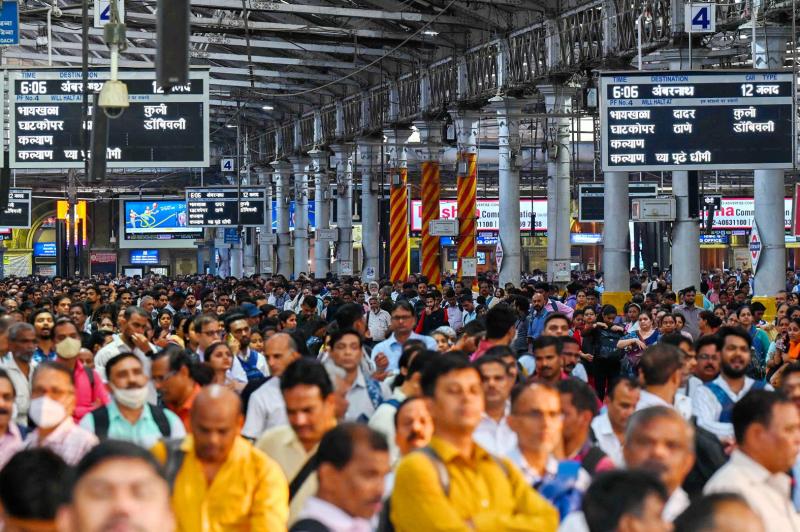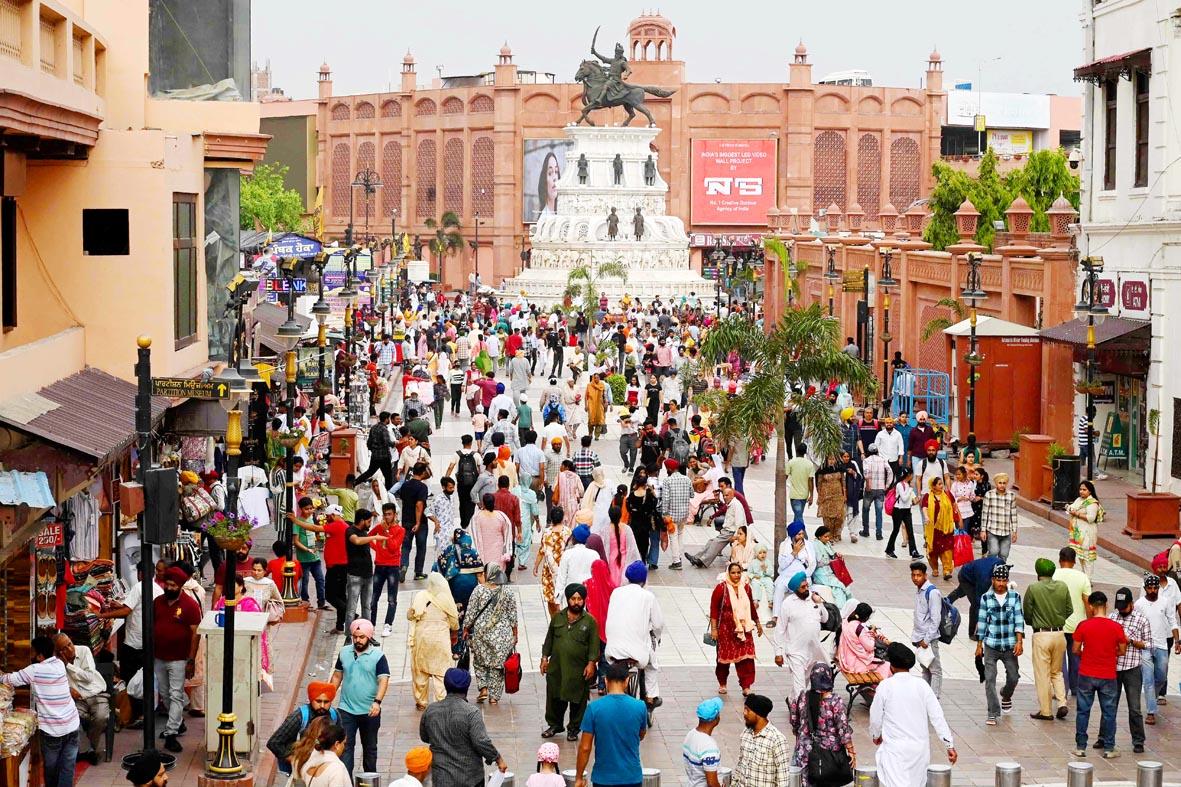India should surpass China’s population midway through this year, according to the latest projection from the UN.
That’s of course unless it’s happened already — or happens later in the year.
Demographers are unsure exactly when India will take the title as the most populous nation in the world because they’re relying on estimates to make their best guess. The latest projection from the UN this week put it at midyear, though that remains an estimate.

Photo: AFP
China has had the most people in the world since at least 1950, the year UN population data began. Both China and India have more than 1.4 billion people, and combined they make up more than a third of the world’s 8 billion people.
“Actually, there is no way we can know exactly when India will surpass China,” said Bruno Schoumaker, a demographer at Universite catholique de Louvain in Belgium. “There is some uncertainty, not only about India’s population, but also China’s population.”
STILL, WHEN IS IT HAPPENING?

Photo: AFP
The UN said in a report Wednesday that India will have about 2.9 million people more than China sometime in the middle of this year — an estimated 1.4286 billion for India, 1.4257 billion for mainland China. But demographers have said the limits of population data make it impossible to calculate an exact date.
Mathematical calculations are made from data including a range of surveys, as well as birth and death records.
“It’s a crude approximation, a best guess,” said Patrick Gerland, chief of the population estimates and projections section at the UN in New York.
Not long ago, India wasn’t expected to become most populous until later this decade. But the timing has been sped up by a drop in China’s fertility rate, with families having fewer children.
HOW IS IT CALCULATED?
Demographers at the UN Population Division make estimates based on projections from a wide variety of data sources to get what they believe are the most up-to-date demographic numbers. The last update to the data used for these calculations for both India and China was July last year, said Sara Hertog, a UN population affairs officer in New York.
The demographers then use a statistical technique to infer when India’s population has surpassed that of China, according to Stuart Gietel-Basten, a professor at Khalifa University of Science and Technology in Abu Dhabi.
“The reality, of course, is that these estimates are just that,” Gietel-Basten said. “But at least they are based on a relatively solid and consistent methodology.”
WHERE DO THE NUMBERS COME FROM?
The foundations of both nations’ numbers are censuses, or head counts, conducted every decade.
China’s last census was in 2020. Demographers used birth and death records, along with other administrative data, to calculate how the population has grown since then.
India’s last census was in 2011. Its scheduled 2021 census was postponed by COVID-19. Without an actual door-to-door count for more than a decade, sample surveys have filled in the gaps to help demographers and India itself understand its population, said Alok Vajpeyi of the New Delhi-based non-government organization, Population Foundation of India.
Among the most important is the Sample Registration System, India’s large-scale demographic survey that gathers data on such things as births, deaths, fertility and more.
Andrea Wojnar, the UN Population Fund’s representative for India, said the agency is confident in the survey’s numbers “because it uses a very robust methodology.”
WHY IS INDIA MOVING AHEAD?
China has an aging population with stagnant growth even after the government seven years ago retreated from a one-child policy, and just two years ago said couples could have three children.
India has a much younger population, a higher fertility rate and a decrease in infant mortality over the last three decades.
India has more babies born each year than in any other country, while China has joined many European countries in having more deaths each year than births, said Dudley Poston, an emeritus professor of sociology at Texas A&M University.
WHY DOES THIS MATTER?
There’s more than bragging rights at stake over which nation is the world’s most populous — there are social and economic consequences. In India, that means a growing labor force and growth that sparks economic activity. In China, that means fewer working-age adults able to support an aging population.
Once a country hits a low fertility level, it’s often hard to recover population growth, even with changes in government policy to encourage more births, said Toshiko Kaneda, technical director of demographic research at the Population Reference Bureau in Washington.
“Psychologically, it will be tough for China, especially given the rivalry in other areas between the two countries,” Gietel-Basten said. “It is a big moment in human history as the baton is passed to India.”

There is a Chinese Communist Party (CCP) plot to put millions at the mercy of the CCP using just released AI technology. This isn’t being overly dramatic. The speed at which AI is improving is exponential as AI improves itself, and we are unprepared for this because we have never experienced anything like this before. For example, a few months ago music videos made on home computers began appearing with AI-generated people and scenes in them that were pretty impressive, but the people would sprout extra arms and fingers, food would inexplicably fly off plates into mouths and text on

On the final approach to Lanshan Workstation (嵐山工作站), logging trains crossed one last gully over a dramatic double bridge, taking the left line to enter the locomotive shed or the right line to continue straight through, heading deeper into the Central Mountains. Today, hikers have to scramble down a steep slope into this gully and pass underneath the rails, still hanging eerily in the air even after the bridge’s supports collapsed long ago. It is the final — but not the most dangerous — challenge of a tough two-day hike in. Back when logging was still underway, it was a quick,

From censoring “poisonous books” to banning “poisonous languages,” the Chinese Nationalist Party (KMT) tried hard to stamp out anything that might conflict with its agenda during its almost 40 years of martial law. To mark 228 Peace Memorial Day, which commemorates the anti-government uprising in 1947, which was violently suppressed, I visited two exhibitions detailing censorship in Taiwan: “Silenced Pages” (禁書時代) at the National 228 Memorial Museum and “Mandarin Monopoly?!” (請說國語) at the National Human Rights Museum. In both cases, the authorities framed their targets as “evils that would threaten social mores, national stability and their anti-communist cause, justifying their actions

In the run-up to World War II, Admiral Wilhelm Canaris, head of Abwehr, Nazi Germany’s military intelligence service, began to fear that Hitler would launch a war Germany could not win. Deeply disappointed by the sell-out of the Munich Agreement in 1938, Canaris conducted several clandestine operations that were aimed at getting the UK to wake up, invest in defense and actively support the nations Hitler planned to invade. For example, the “Dutch war scare” of January 1939 saw fake intelligence leaked to the British that suggested that Germany was planning to invade the Netherlands in February and acquire airfields